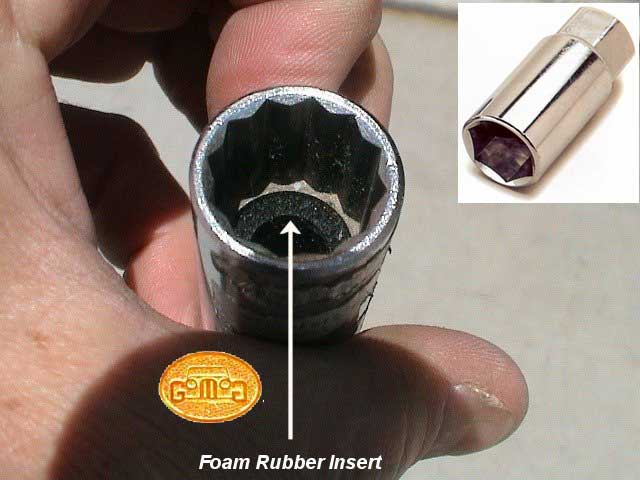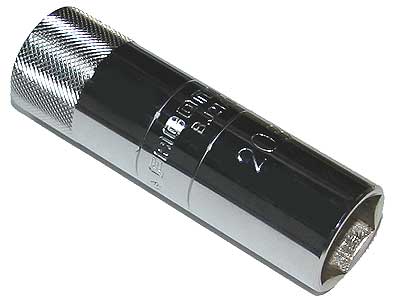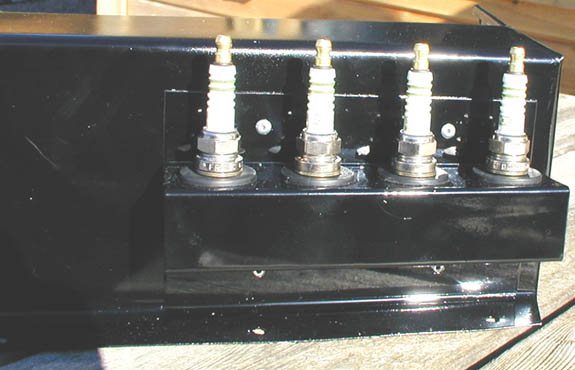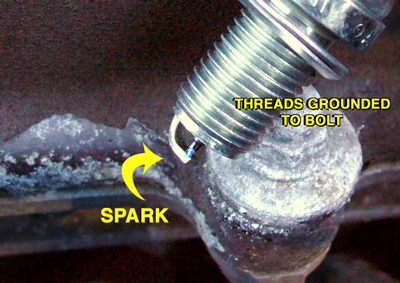 INSTALLING
AND REMOVING SPARK PLUGS
INSTALLING
AND REMOVING SPARK PLUGS
by Lorne Goldman
 Spark
plugs are simple things. People wax eloquently forever on which one
will give them moe power. However, that is a waste of time. A great
match does no light a bigger bonfire. However some
plugs types will last longer than others and provide a better ignition.
Spark
plugs should be checked and changed regularly. Over time the spark
plugs
electrodes will wear, and change the all important gap that shapes the
spark.
As well, over a long period, if not changed, the spark plug threads
will fuse with
the motor threads. This will often strip the motor's threads requiring
a helicoil (if you are lucky).
Spark
plugs are simple things. People wax eloquently forever on which one
will give them moe power. However, that is a waste of time. A great
match does no light a bigger bonfire. However some
plugs types will last longer than others and provide a better ignition.
Spark
plugs should be checked and changed regularly. Over time the spark
plugs
electrodes will wear, and change the all important gap that shapes the
spark.
As well, over a long period, if not changed, the spark plug threads
will fuse with
the motor threads. This will often strip the motor's threads requiring
a helicoil (if you are lucky).
Installing
and removing plugs are a trick as well. If
you use the wrong tool, the possibility of breaking the plug is very
high.
The proper tool is called a spark plug socket and they come in sizes
that
match all spark plugs types. They are made for this task and have a
foam,
silicone or rubber insert that protects the plug from shattering. They
look different in Europe versus North America so I have provided a
picture of both types. I carry one in my Morgans. Other spark plug
questions
are addressed in the Ignition
Index.
If you are interested. I use NGK Iridiums.
Spark Plugs and Power
by NGK and Lorne Goldman
From the NGK site.
"A common misconception is that changing spark plugs will result in a
large power increase. In most cases, removing even seriously worn out
spark plugs will only result in very modest power gains, typically about
1-2% of total engine output. This could be even less for
computer-controlled vehicles, primarily because most newer vehicles have
more powerful ignition systems and the vehicle's computer can make
adjustments so that vehicle operation seems smoother and more seamless.
Many
people think that simply supplying more spark to the firing tip can and
will combust more fuel. What they don't understand is that most newer
car engines are so efficient that they are already burning all of the
available fuel. Simply adding more spark voltage can't burn more fuel
because there is no more fuel to burn.

When a stock or near-stock engine is given a fresh set of spark plugs, peak efficiency is
restored. The power gains that come from this restored state of tune are
usually minimal. Any company that tells you that their spark plug will
provide significant gains in power in a stock or near-stock engine is
making blanket statements that may not be supportable."
| WATCHPOINT: How true! Any tales
that someone tries to sell you to the effect that a spark plug, of
any type or cost, can increase horsepower is bunk. That is analogous
to asserting that a better match will create a bigger bonfire. One
has nothing to do with the other. A better spark can steady or
restore your engine running to its production ideal, but nothing more
(and that is more than enough to justify the purchase of the best
spark plug!). Power is a function of other things. |
 A Morgan Spark Plug Holder
A Morgan Spark Plug Holder
by Einar Aagotnes
For a good deal of space saving and ease of access this
spark plug holder was fashioned and attached to the bulkhead tool box.
Checking for a Spark
by Lorne Goldman
Remove
a plug wire and insert an old spark plug into the end of the wire
(the plug boot). Place the spark plug on a metal surface on the engine.
Then crank the engine to check for a spark. No spark
indicates an ignition problem. It is best done with two people as the
spark is very faint and blue, a bit hard to see, especially in the
light. A darkened garage makes it easier for one person to see it.
 Spark
plugs are simple things. People wax eloquently forever on which one
will give them moe power. However, that is a waste of time. A great
match does no light a bigger bonfire. However some
plugs types will last longer than others and provide a better ignition.
Spark
plugs should be checked and changed regularly. Over time the spark
plugs
electrodes will wear, and change the all important gap that shapes the
spark.
As well, over a long period, if not changed, the spark plug threads
will fuse with
the motor threads. This will often strip the motor's threads requiring
a helicoil (if you are lucky).
Spark
plugs are simple things. People wax eloquently forever on which one
will give them moe power. However, that is a waste of time. A great
match does no light a bigger bonfire. However some
plugs types will last longer than others and provide a better ignition.
Spark
plugs should be checked and changed regularly. Over time the spark
plugs
electrodes will wear, and change the all important gap that shapes the
spark.
As well, over a long period, if not changed, the spark plug threads
will fuse with
the motor threads. This will often strip the motor's threads requiring
a helicoil (if you are lucky).
 INSTALLING
AND REMOVING SPARK PLUGS
INSTALLING
AND REMOVING SPARK PLUGS
 A Morgan Spark Plug
A Morgan Spark Plug